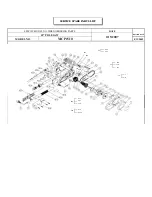
ASSEMBLY AND OPERATION
Assembly of the tile cutter on the
workbench
Figure 2 shows the dimensions of mounting
holes which have been pre-drilled on the
machine frame.
1. Drill three holes in the workbench as the
same dimensions as Fig. 2.
2. Fasten the machine with bolt onto the
workbench.
WARNING!
Only use the machine after it has
been assembled completely and it has been
screwed onto the workbench.
Figure 2:
dimensions of mounting holes
Cut preparation
WARNING!
To avoid serious personal injury,
read and become familiar with the instruction
manual before making any cuts with this tile
cutting machine.
WARNING!
Damage to your eyes, lungs, and
ears could result from failure to wear safety
glasses, a dust mask, and hearing protection
while cutting with the machine.
Rip cutting
1. Using a marking pencil, mark the cut line
on a piece of tile.
2. Unlock the parallel (Figure 3) guide and
slide it to the edge of the table.
Figure 3:
Parallel guide locking knob
3. Line up the cut line on the tile with the
diamond blade.
4. Adjust the parallel guide against the edge
of the tile and lock the parallel guide into
position.
5. Turn the machine ON and allow it to reach
full speed. Be sure the blade runs
smoothly. The blade should also be wet
from the water tank below the machine.
6. Keeping your fingers out of the cutting
path, slowly slide the tile into the moving
blade.
Note
-DO NOT feed the tile into the
blade too fast.
45
0
Miter cutting
Diagonal cuts can be made on rectangular
tiles using the supplied miter gauge. Figure 4
shows a typical set up for cutting the corner off
a square tile.
- 10 -
Summary of Contents for TILE SAW 60707
Page 12: ...EXPLODED VIEW 12...
































